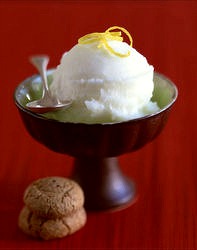
Stock photo
Amaretti are essentially gluten-free (gluten free) almond meringues (you can find them in many specialty food stores under the brand Amaretti di Saronno). I like to serve them with the recipe for Raspberry Pana Cotta or Panacotta.
Says Michael Recchiuti, “As a teenager, I worked at my dad's grocery market and one of my jobs was restocking shelves. That's how I was first introduced to the delicate Amaretti cookies wrapped in bright wrappers and packed into colorful tins. Legend has it that they were invented by a young Italian baker in the 18th century for the Cardinal of Milan. I learned how to make them from a woman named Carmella while I was working at her son' ’s pizzeria on South Street in Philadelphia. They go great with a shot of espresso, a scoop of gelato or even an afternoon tea.”
COOKIE RECIPE HELP / GLUTEN-FREE RECIPE HELP
INGREDIENTS
1 1/8 cups whole almonds, blanched
1 1/2 teaspoons cornstarch
1/2 cup powdered sugar
2 large egg whites
1/8 teaspoon cream of tartar
1/3 cup sugar
1/4 teaspoon pure almond extract
INSTRUCTIONS
1. Position a shelf in the middle of the oven and preheat the oven to 300 degrees F. Line the bottoms of two 12- x 18-inch baking sheet pans with parchment paper.
2. Combine half of the almonds with the half of the cornstarch in a food processor fitted with a steel blade. PULSE to grind into a fine, dry meal. Scrape into a waiting medium-size bowl. Repeat with the remaining almonds and cornstarch.
SARAH SAYS: Make sure you PULSE the food processor and don't grind the nuts into nut butter.
3. Sift the almond and cornstarch meal and reprocess and large almond pieces; you want to have very fine almond meal.
4. Combine the almond meal with powdered sugar; sift the powdered sugar over the almond meal and stir to combine. Set aside.
5. Put the egg whites and cream of tartar in the bowl of a stand mixer fitted with the whisk (balloon) attachment. Beat on medium speed until they start to froth and then add about half of the granulated sugar, slowly at the side of the bowl. When they start to become stiff, increase the speed to high and add the almond extract, and the rest of the sugar, slowly at the side of the bowl. Beat until the whites start to lose their shine but still look wet. They will hang in stiff peaks when the whip is lifted from the bowl.
6. Fold half of the almond mixture into the whites with a rubber spatula. Fold in the rest of the almond mixture just until no white streaks of egg whites remain. Using a pastry bag fitted with a #1 tip, pipe 1-inch mounds of the batter onto the prepared pans, spacing them about 1-inch apart. (You may drop the batter by tablespoonfuls rather than piping.)
7. Bake on the middle shelves of the oven, rotating the pans 180 degrees halfway through the baking time of 35 to 40 minutes.
After 30 minutes, remove one of the cookies and check the bottom. If it is moist, cook for an additional 5 to 10 minutes. If it is smooth and dry, cook for an additional 5 minutes.
8. After the initial baking time, turn off the oven and crack the door slightly. Allow the cookies to dry in the oven for an additional 20 minutes.
9. Then remove them from the oven and let them cool completely on the sheet pans, on wire racks.
STORAGE
Store in an airtight container at room temperature, for up to 1 week.
Recipe adapted from Chocolatier Magazine, Michael Recchiuti


